Dezhong Peng
Reliable Disentanglement Multi-view Learning Against View Adversarial Attacks
May 07, 2025Abstract:Recently, trustworthy multi-view learning has attracted extensive attention because evidence learning can provide reliable uncertainty estimation to enhance the credibility of multi-view predictions. Existing trusted multi-view learning methods implicitly assume that multi-view data is secure. In practice, however, in safety-sensitive applications such as autonomous driving and security monitoring, multi-view data often faces threats from adversarial perturbations, thereby deceiving or disrupting multi-view learning models. This inevitably leads to the adversarial unreliability problem (AUP) in trusted multi-view learning. To overcome this tricky problem, we propose a novel multi-view learning framework, namely Reliable Disentanglement Multi-view Learning (RDML). Specifically, we first propose evidential disentanglement learning to decompose each view into clean and adversarial parts under the guidance of corresponding evidences, which is extracted by a pretrained evidence extractor. Then, we employ the feature recalibration module to mitigate the negative impact of adversarial perturbations and extract potential informative features from them. Finally, to further ignore the irreparable adversarial interferences, a view-level evidential attention mechanism is designed. Extensive experiments on multi-view classification tasks with adversarial attacks show that our RDML outperforms the state-of-the-art multi-view learning methods by a relatively large margin.
Robust Duality Learning for Unsupervised Visible-Infrared Person Re-Identfication
May 05, 2025Abstract:Unsupervised visible-infrared person re-identification (UVI-ReID) aims to retrieve pedestrian images across different modalities without costly annotations, but faces challenges due to the modality gap and lack of supervision. Existing methods often adopt self-training with clustering-generated pseudo-labels but implicitly assume these labels are always correct. In practice, however, this assumption fails due to inevitable pseudo-label noise, which hinders model learning. To address this, we introduce a new learning paradigm that explicitly considers Pseudo-Label Noise (PLN), characterized by three key challenges: noise overfitting, error accumulation, and noisy cluster correspondence. To this end, we propose a novel Robust Duality Learning framework (RoDE) for UVI-ReID to mitigate the effects of noisy pseudo-labels. First, to combat noise overfitting, a Robust Adaptive Learning mechanism (RAL) is proposed to dynamically emphasize clean samples while down-weighting noisy ones. Second, to alleviate error accumulation-where the model reinforces its own mistakes-RoDE employs dual distinct models that are alternately trained using pseudo-labels from each other, encouraging diversity and preventing collapse. However, this dual-model strategy introduces misalignment between clusters across models and modalities, creating noisy cluster correspondence. To resolve this, we introduce Cluster Consistency Matching (CCM), which aligns clusters across models and modalities by measuring cross-cluster similarity. Extensive experiments on three benchmarks demonstrate the effectiveness of RoDE.
LLaVA-ReID: Selective Multi-image Questioner for Interactive Person Re-Identification
Apr 15, 2025Abstract:Traditional text-based person ReID assumes that person descriptions from witnesses are complete and provided at once. However, in real-world scenarios, such descriptions are often partial or vague. To address this limitation, we introduce a new task called interactive person re-identification (Inter-ReID). Inter-ReID is a dialogue-based retrieval task that iteratively refines initial descriptions through ongoing interactions with the witnesses. To facilitate the study of this new task, we construct a dialogue dataset that incorporates multiple types of questions by decomposing fine-grained attributes of individuals. We further propose LLaVA-ReID, a question model that generates targeted questions based on visual and textual contexts to elicit additional details about the target person. Leveraging a looking-forward strategy, we prioritize the most informative questions as supervision during training. Experimental results on both Inter-ReID and text-based ReID benchmarks demonstrate that LLaVA-ReID significantly outperforms baselines.
Deep Reversible Consistency Learning for Cross-modal Retrieval
Jan 10, 2025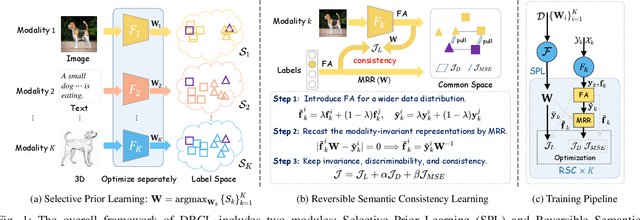

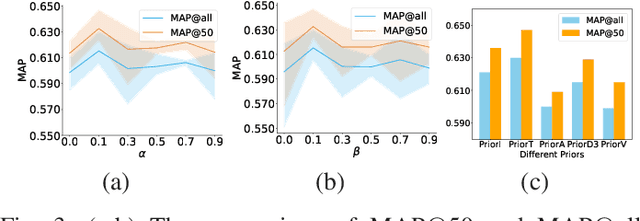
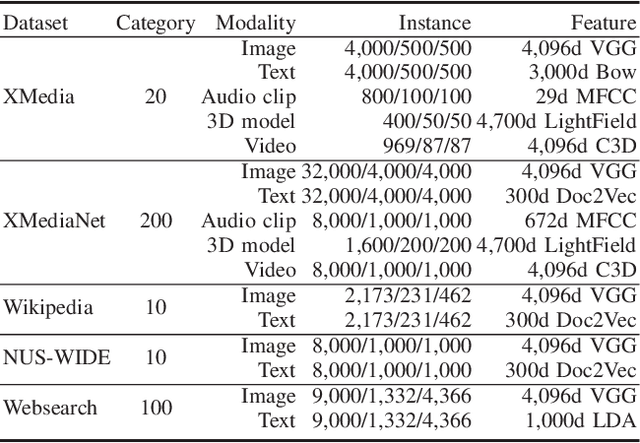
Abstract:Cross-modal retrieval (CMR) typically involves learning common representations to directly measure similarities between multimodal samples. Most existing CMR methods commonly assume multimodal samples in pairs and employ joint training to learn common representations, limiting the flexibility of CMR. Although some methods adopt independent training strategies for each modality to improve flexibility in CMR, they utilize the randomly initialized orthogonal matrices to guide representation learning, which is suboptimal since they assume inter-class samples are independent of each other, limiting the potential of semantic alignments between sample representations and ground-truth labels. To address these issues, we propose a novel method termed Deep Reversible Consistency Learning (DRCL) for cross-modal retrieval. DRCL includes two core modules, \ie Selective Prior Learning (SPL) and Reversible Semantic Consistency learning (RSC). More specifically, SPL first learns a transformation weight matrix on each modality and selects the best one based on the quality score as the Prior, which greatly avoids blind selection of priors learned from low-quality modalities. Then, RSC employs a Modality-invariant Representation Recasting mechanism (MRR) to recast the potential modality-invariant representations from sample semantic labels by the generalized inverse matrix of the prior. Since labels are devoid of modal-specific information, we utilize the recast features to guide the representation learning, thus maintaining semantic consistency to the fullest extent possible. In addition, a feature augmentation mechanism (FA) is introduced in RSC to encourage the model to learn over a wider data distribution for diversity. Finally, extensive experiments conducted on five widely used datasets and comparisons with 15 state-of-the-art baselines demonstrate the effectiveness and superiority of our DRCL.
Robust Self-Paced Hashing for Cross-Modal Retrieval with Noisy Labels
Jan 03, 2025



Abstract:Cross-modal hashing (CMH) has appeared as a popular technique for cross-modal retrieval due to its low storage cost and high computational efficiency in large-scale data. Most existing methods implicitly assume that multi-modal data is correctly labeled, which is expensive and even unattainable due to the inevitable imperfect annotations (i.e., noisy labels) in real-world scenarios. Inspired by human cognitive learning, a few methods introduce self-paced learning (SPL) to gradually train the model from easy to hard samples, which is often used to mitigate the effects of feature noise or outliers. It is a less-touched problem that how to utilize SPL to alleviate the misleading of noisy labels on the hash model. To tackle this problem, we propose a new cognitive cross-modal retrieval method called Robust Self-paced Hashing with Noisy Labels (RSHNL), which can mimic the human cognitive process to identify the noise while embracing robustness against noisy labels. Specifically, we first propose a contrastive hashing learning (CHL) scheme to improve multi-modal consistency, thereby reducing the inherent semantic gap. Afterward, we propose center aggregation learning (CAL) to mitigate the intra-class variations. Finally, we propose Noise-tolerance Self-paced Hashing (NSH) that dynamically estimates the learning difficulty for each instance and distinguishes noisy labels through the difficulty level. For all estimated clean pairs, we further adopt a self-paced regularizer to gradually learn hash codes from easy to hard. Extensive experiments demonstrate that the proposed RSHNL performs remarkably well over the state-of-the-art CMH methods.
ROUTE: Robust Multitask Tuning and Collaboration for Text-to-SQL
Dec 13, 2024



Abstract:Despite the significant advancements in Text-to-SQL (Text2SQL) facilitated by large language models (LLMs), the latest state-of-the-art techniques are still trapped in the in-context learning of closed-source LLMs (e.g., GPT-4), which limits their applicability in open scenarios. To address this challenge, we propose a novel RObust mUltitask Tuning and collaboration mEthod (ROUTE) to improve the comprehensive capabilities of open-source LLMs for Text2SQL, thereby providing a more practical solution. Our approach begins with multi-task supervised fine-tuning (SFT) using various synthetic training data related to SQL generation. Unlike existing SFT-based Text2SQL methods, we introduced several additional SFT tasks, including schema linking, noise correction, and continuation writing. Engaging in a variety of SQL generation tasks enhances the model's understanding of SQL syntax and improves its ability to generate high-quality SQL queries. Additionally, inspired by the collaborative modes of LLM agents, we introduce a Multitask Collaboration Prompting (MCP) strategy. This strategy leverages collaboration across several SQL-related tasks to reduce hallucinations during SQL generation, thereby maximizing the potential of enhancing Text2SQL performance through explicit multitask capabilities. Extensive experiments and in-depth analyses have been performed on eight open-source LLMs and five widely-used benchmarks. The results demonstrate that our proposal outperforms the latest Text2SQL methods and yields leading performance.
PointCloud-Text Matching: Benchmark Datasets and a Baseline
Mar 28, 2024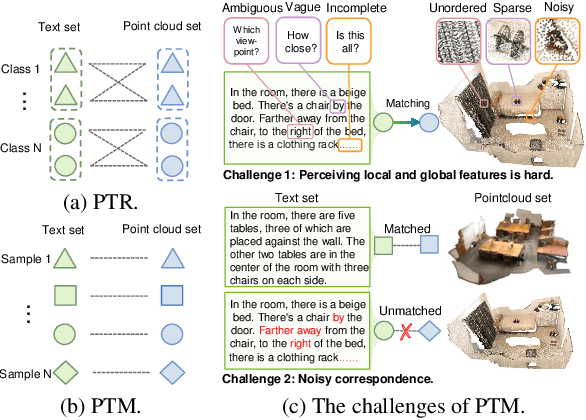



Abstract:In this paper, we present and study a new instance-level retrieval task: PointCloud-Text Matching~(PTM), which aims to find the exact cross-modal instance that matches a given point-cloud query or text query. PTM could be applied to various scenarios, such as indoor/urban-canyon localization and scene retrieval. However, there exists no suitable and targeted dataset for PTM in practice. Therefore, we construct three new PTM benchmark datasets, namely 3D2T-SR, 3D2T-NR, and 3D2T-QA. We observe that the data is challenging and with noisy correspondence due to the sparsity, noise, or disorder of point clouds and the ambiguity, vagueness, or incompleteness of texts, which make existing cross-modal matching methods ineffective for PTM. To tackle these challenges, we propose a PTM baseline, named Robust PointCloud-Text Matching method (RoMa). RoMa consists of two modules: a Dual Attention Perception module (DAP) and a Robust Negative Contrastive Learning module (RNCL). Specifically, DAP leverages token-level and feature-level attention to adaptively focus on useful local and global features, and aggregate them into common representations, thereby reducing the adverse impact of noise and ambiguity. To handle noisy correspondence, RNCL divides negative pairs, which are much less error-prone than positive pairs, into clean and noisy subsets, and assigns them forward and reverse optimization directions respectively, thus enhancing robustness against noisy correspondence. We conduct extensive experiments on our benchmarks and demonstrate the superiority of our RoMa.
Cross-modal Active Complementary Learning with Self-refining Correspondence
Oct 26, 2023



Abstract:Recently, image-text matching has attracted more and more attention from academia and industry, which is fundamental to understanding the latent correspondence across visual and textual modalities. However, most existing methods implicitly assume the training pairs are well-aligned while ignoring the ubiquitous annotation noise, a.k.a noisy correspondence (NC), thereby inevitably leading to a performance drop. Although some methods attempt to address such noise, they still face two challenging problems: excessive memorizing/overfitting and unreliable correction for NC, especially under high noise. To address the two problems, we propose a generalized Cross-modal Robust Complementary Learning framework (CRCL), which benefits from a novel Active Complementary Loss (ACL) and an efficient Self-refining Correspondence Correction (SCC) to improve the robustness of existing methods. Specifically, ACL exploits active and complementary learning losses to reduce the risk of providing erroneous supervision, leading to theoretically and experimentally demonstrated robustness against NC. SCC utilizes multiple self-refining processes with momentum correction to enlarge the receptive field for correcting correspondences, thereby alleviating error accumulation and achieving accurate and stable corrections. We carry out extensive experiments on three image-text benchmarks, i.e., Flickr30K, MS-COCO, and CC152K, to verify the superior robustness of our CRCL against synthetic and real-world noisy correspondences.
Image Clustering with External Guidance
Oct 18, 2023



Abstract:The core of clustering is incorporating prior knowledge to construct supervision signals. From classic k-means based on data compactness to recent contrastive clustering guided by self-supervision, the evolution of clustering methods intrinsically corresponds to the progression of supervision signals. At present, substantial efforts have been devoted to mining internal supervision signals from data. Nevertheless, the abundant external knowledge such as semantic descriptions, which naturally conduces to clustering, is regrettably overlooked. In this work, we propose leveraging external knowledge as a new supervision signal to guide clustering, even though it seems irrelevant to the given data. To implement and validate our idea, we design an externally guided clustering method (Text-Aided Clustering, TAC), which leverages the textual semantics of WordNet to facilitate image clustering. Specifically, TAC first selects and retrieves WordNet nouns that best distinguish images to enhance the feature discriminability. Then, to improve image clustering performance, TAC collaborates text and image modalities by mutually distilling cross-modal neighborhood information. Experiments demonstrate that TAC achieves state-of-the-art performance on five widely used and three more challenging image clustering benchmarks, including the full ImageNet-1K dataset.
Decoupled Contrastive Multi-view Clustering with High-order Random Walks
Aug 22, 2023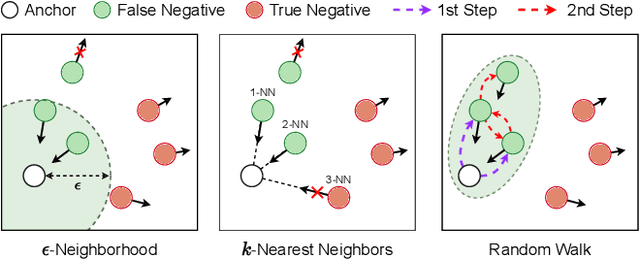
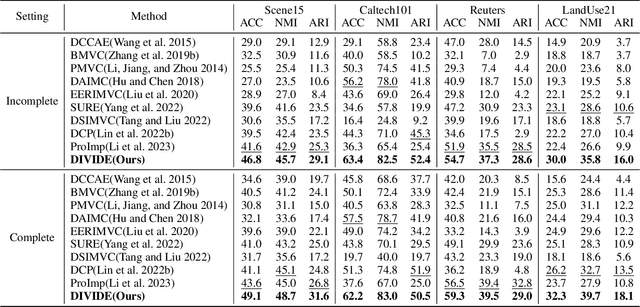
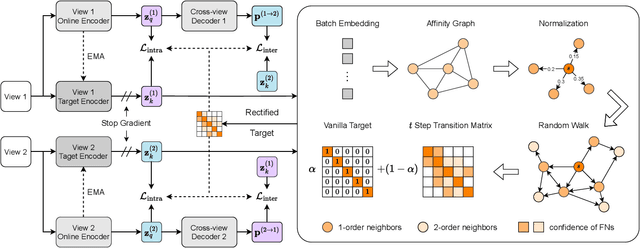
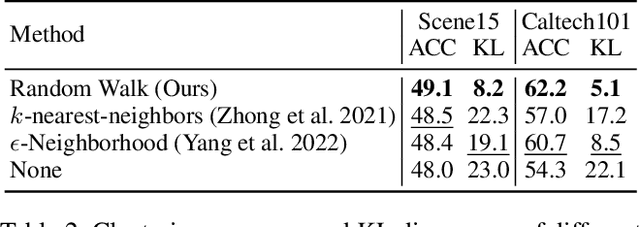
Abstract:In recent, some robust contrastive multi-view clustering (MvC) methods have been proposed, which construct data pairs from neighborhoods to alleviate the false negative issue, i.e., some intra-cluster samples are wrongly treated as negative pairs. Although promising performance has been achieved by these methods, the false negative issue is still far from addressed and the false positive issue emerges because all in- and out-of-neighborhood samples are simply treated as positive and negative, respectively. To address the issues, we propose a novel robust method, dubbed decoupled contrastive multi-view clustering with high-order random walks (DIVIDE). In brief, DIVIDE leverages random walks to progressively identify data pairs in a global instead of local manner. As a result, DIVIDE could identify in-neighborhood negatives and out-of-neighborhood positives. Moreover, DIVIDE embraces a novel MvC architecture to perform inter- and intra-view contrastive learning in different embedding spaces, thus boosting clustering performance and embracing the robustness against missing views. To verify the efficacy of DIVIDE, we carry out extensive experiments on four benchmark datasets comparing with nine state-of-the-art MvC methods in both complete and incomplete MvC settings.
 Add to Chrome
Add to Chrome Add to Firefox
Add to Firefox Add to Edge
Add to Edge